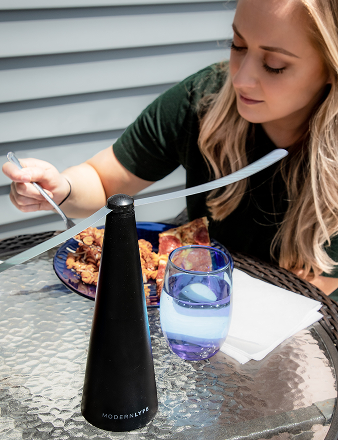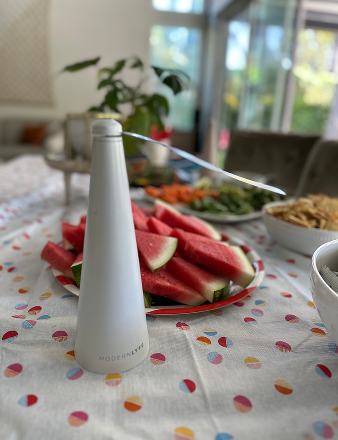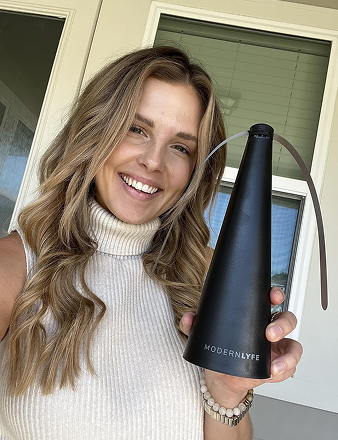Yes, they do. Outdoor fans are a highly effective, chemical-free way to keep bugs from crashing your party. This isn't a gimmick; it's physics. A strong, steady airflow creates an invisible barrier that weak fliers like mosquitoes, flies, and gnats can't push through. The result is a cool, comfortable, bug-free zone for you to enjoy.
Your Chemical-Free Solution for a Bug-Free Patio
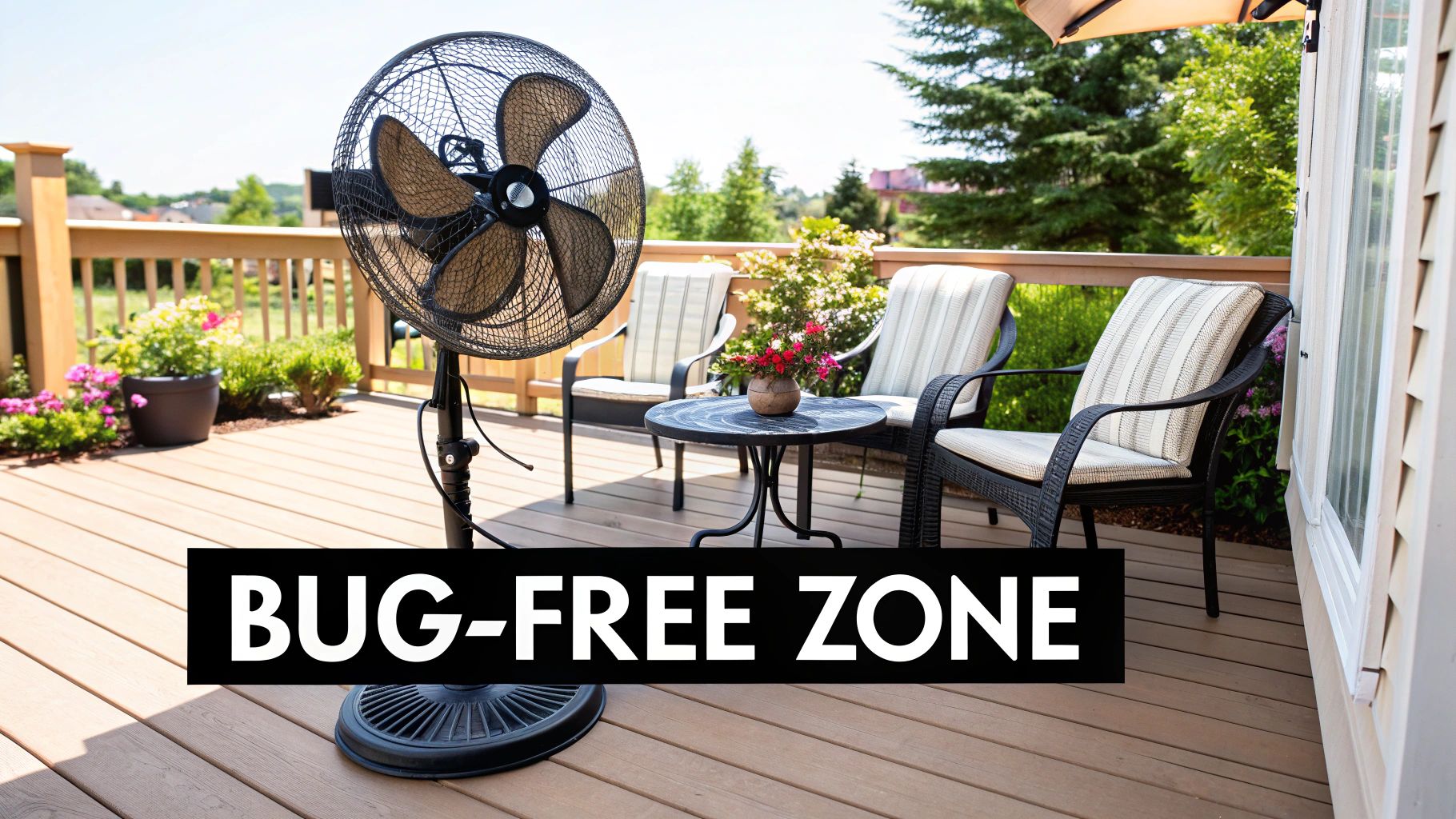
You know the drill. You're trying to enjoy dinner on the deck or host a backyard barbecue, but uninvited guests arrive. The buzzing of flies and swatting at mosquitoes can turn a perfect evening into a frustrating retreat indoors.
Many people reach for sprays, candles, or traps. While these solutions can work, they're often temporary, messy, or involve chemicals you might not want around your food, kids, and pets. An outdoor fan is a clean, simple, and effective alternative.
Think of it less as blowing air and more as creating a protective bubble around your space. This invisible shield does two critical things to reclaim your patio from pests.
The Power of Airflow
The main reason fans work is by creating a physical obstacle. Most flying insects that bother us—especially mosquitoes and gnats—are terrible flyers. A steady breeze makes it incredibly difficult, if not impossible, for them to navigate and land where they want to.
You're creating a personal no-fly zone.
But that's not all. The airflow also disperses the signals that attract bugs in the first place. Mosquitoes are experts at tracking the carbon dioxide (CO2) we exhale. A fan scatters your scent, making you invisible to them.
This one-two punch makes fans a reliable deterrent. If flies are your main issue, we cover specific tactics in our guide on the best outdoor fly repellers.
By creating a powerful, targeted breeze, you're not just cooling down—you're establishing an active defense system against the most common outdoor insects.
The demand for better pest solutions is clear. The global insect repellent market, valued at USD 5.7 billion, is expected to nearly double to USD 11.7 billion by 2035. This growth highlights a clear need for effective methods, and the simple fan is a powerful, non-chemical approach that works.
How a Simple Breeze Makes You Invisible to Bugs
Ever notice fewer pests on a breezy day at the beach? It's not your imagination. The same principle makes outdoor fans so effective against bugs, and it works in two key ways.
First, the fan's airflow acts like a river current. Tiny insects, from gnats to mosquitoes, are weak flyers. Their small bodies and delicate wings can't handle a steady breeze. They get caught in the current and are pushed away before they can land on you.
But the physical barrier is only half the story. The fan also makes you undetectable.
Hiding You from a Bug's Built-In GPS
Flying pests, particularly mosquitoes, are expert hunters. They don't just find you by sight; they use a sophisticated tracking system that hones in on the chemical signals you constantly emit.
The biggest beacon is the carbon dioxide (CO2) you exhale. Mosquitoes can detect this from a surprising distance. They also lock onto other organic compounds on your skin. Together, these clues create a "scent trail" that leads them straight to you.
An outdoor fan acts as your personal cloaking device. As it circulates the air, it grabs that scent trail and scatters it. The CO2 from your breath gets so diluted and dispersed that a mosquito can't get a clear lock on your position. Without a trail to follow, they become confused and fly by, completely unaware of your presence.
The fan scrambles the signals. The constant air movement turns your distinct scent signature into random background noise, making you effectively invisible to their senses.
This combination of physical force and scent camouflage is what makes outdoor fans to keep bugs away such a powerful tool for taking back your patio.
It's All About Air Speed
You don't need a wind tunnel to achieve this. The amount of airflow required is surprisingly minimal. To successfully throw a mosquito off course, a fan just needs to create an airflow slightly faster than its top flight speed—which is only about 1 to 1.5 mph.
That gentle breeze is more than enough to disrupt their flight and disperse your scent. You can learn more from these insights on how fans deter mosquitoes from The New York Times.
This means even a fan on a low setting offers fantastic protection. The key is creating consistent, gentle air movement across your seating area. It keeps bugs away and keeps you cool without any chemical sprays.
Choosing the Right Fan for Maximum Bug Protection
Picking the right outdoor fan isn't just about moving air—it's about creating a bug-free zone. Not just any fan will do the job. Here's what to look for to turn your patio into a no-fly zone for pests.
The most important factor is CFM, which stands for Cubic Feet per Minute. This number measures how much air a fan can move. Think of it as the fan's power; a higher CFM means a stronger airflow that can physically stop bugs.
For an average patio, you'll want a fan with a CFM rating of at least 2,000 to 3,000. That's the sweet spot for generating an airflow powerful enough to act as an invisible shield against weak fliers like mosquitoes and to disperse the scents that attract them.
Matching Airflow Power to Your Patio Size
A tiny desk fan won't work on a large deck, and an industrial fan is overkill for a small balcony. Matching the fan's CFM to your space is key.
- Small Patios & Balconies (Under 150 sq. ft.): A fan in the 1,500 - 2,500 CFM range is perfect. A pedestal or wall-mounted fan can easily cover this size.
- Medium Patios & Decks (150 - 300 sq. ft.): You'll need more power. Aim for a CFM of 3,000 - 5,000. Larger pedestal fans and many outdoor ceiling fans excel here.
- Large Outdoor Spaces (Over 300 sq. ft.): For big areas, you’ll want a high-CFM ceiling fan (5,000+ CFM) or several smaller fans placed strategically to create overlapping zones of protection.
Most fans have adjustable speed settings, giving you control. The panel below is a great example of how you can easily increase power when bugs are bad or dial it back for a gentle breeze.
This simple feature lets you find the perfect balance between comfort and pest control.
Why Durability and Safety Ratings Matter
An outdoor fan lives outside, so it needs to be tough enough to handle the elements. This is where safety ratings are critical.
Using an indoor-rated fan outside is a huge mistake. They aren't built to handle moisture, which can lead to rusted parts, electrical shorts, and a serious safety hazard.
When shopping, look for two specific ratings:
- Damp-Rated Fans: These are designed for humidity and ambient moisture but can't be directly exposed to rain. They are ideal for covered porches, screened-in patios, and gazebos.
- Wet-Rated Fans: This is your heavy-duty option. Built with waterproof motor casings and all-weather blades, these fans can handle direct rain, snow, and salt spray. They're perfect for pergolas, open decks, and coastal homes.
Choosing the right rating ensures your fan is safe and will last for seasons. If you're ready to look at specific models, our guide to the best outdoor fans for mosquitoes is a great place to start.
Mastering Fan Placement for a Pest-Free Zone
A powerful outdoor fan is a great start, but placement is everything. Where you put the fan is what turns it from a simple breeze-maker into a bug-repelling fortress. The goal is to strategically build an invisible, pest-free perimeter right where you need it.
You want to create a "bubble of protection." This isn't about blasting air randomly. You're directing the airflow to form a consistent barrier that stops insects before they get close. A fan in the right spot disrupts their flight patterns and disperses the scents they use to find you.
Creating Your Bubble of Protection
Think of your patio or deck as a map. Your seating area, dining table, or grill is the territory you need to defend. First, pinpoint where people gather or where food is served.
Your best strategy is to create a cross-breeze. One fan helps, but two or more is a game-changer. Placing them on opposite sides of your bug-free zone generates an overlapping current of air that covers the whole space, leaving no gaps for pests.
The biggest mistake is putting a fan inside your seating area and pointing it out. Do the opposite. Place fans on the perimeter, blowing across the space. This creates that wall of air bugs must fight through to reach you.
Aim Low for Maximum Impact
While a cool breeze on your face is nice, the secret to stopping the worst pests is to aim the airflow lower. Mosquitoes, for example, often bite ankles and legs because they fly low, tracking the carbon dioxide that settles near the ground.
You can disrupt their strategy by placing a portable or pedestal fan at a low angle.
- Aim for the Ankles: Point the airflow across the lower half of your seating area. This creates turbulence that low-flying insects can't handle.
- Intercept Flight Paths: Position fans to blow air away from where you're sitting. This barrier intercepts bugs before they sense you're there. To get this right, learn more about how positioning fans can deter mosquitoes from Bob Vila.
- Cover All Angles: With one fan, place it upwind. The breeze will naturally carry across your entire space.
For smaller jobs, like keeping flies off a picnic table, a specialized device works wonders. See this in action in our guide on using a dedicated fly repellent fan to guard your food.
Mastering these placement tricks ensures your outdoor fans to keep bugs away do their job perfectly, giving you total control over your backyard.
Boosting Your Fan's Repellent Power
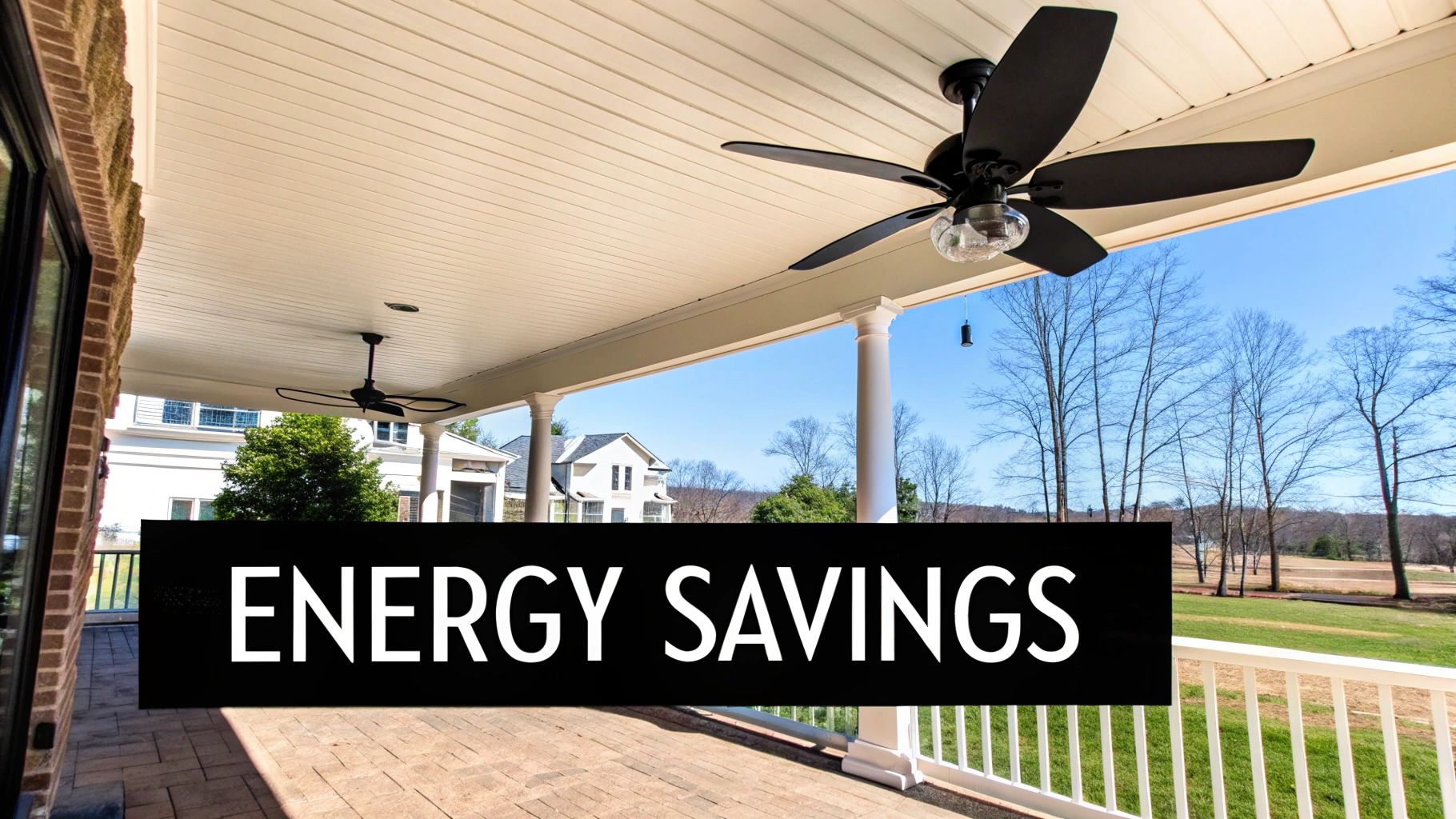
A strong breeze from a fan is your first line of defense, but you don't have to stop there. Think of your fan as a delivery system. You can use it to amplify other bug-deterring methods and create a seriously effective barrier.
One of the best upgrades is a fan with a built-in misting feature. These fans connect to a hose and spray a fine vapor into the air. This offers two benefits: it cools down your space on a hot day while creating an environment that bugs, especially mosquitoes, hate. The cool, damp air makes it harder for them to fly and find you.
Introducing Natural Repellents
You can combine your fan’s airflow with natural repellents for a huge boost in effectiveness. Instead of letting a citronella candle passively scent a small area, use the fan to actively push those bug-repelling scents all over your patio.
This simple trick turns a passive repellent into an active, space-clearing shield.
- Essential Oil Diffusers: Set up a diffuser with oils like citronella, lemongrass, peppermint, or eucalyptus directly in the fan's path. The breeze will carry the scent everywhere.
- Repellent-Soaked Ribbons: For an easy DIY trick, soak cloth ribbons in a mix of water and your chosen essential oil, then tie them to the fan's safety cage. The airflow does all the work.
The real magic is combining a powerful air current with scents bugs can't stand. The fan doesn’t just physically blow them away; it creates a scented barrier that actively pushes them out.
This is backed by research. Studies show that using a fan to distribute a spatial repellent can slash mosquito landings by an incredible 95%. The fan's airstream is an extremely efficient way to make a repellent more powerful than it could be on its own. You can dive into the science and read more about how fans boost repellent effectiveness in this study.
By adding these simple layers to your setup, you can turn a basic fan into a sophisticated defense system that keeps your outdoor space comfortable and pest-free without harsh chemicals.
Got Questions? Here’s What People Often Ask About Bug-Repelling Fans
Even after you understand the basics—that fans disrupt a bug's flight—practical questions often come up. Here are a few of the most common ones.
How Much Fan Power Do I Need for a Big Patio?
For a patio over 300 square feet, one fan probably won't be enough. You'll end up with calm spots where bugs can still gather. The best strategy is to create overlapping zones of air movement with multiple fans, rather than relying on one giant machine.
A good starting point is a powerful ceiling fan as your anchor, something with a high CFM rating of 5,000 or more. Then, add one or two pedestal or wall-mounted fans—each around 2,000-3,000 CFM—to target specific seating areas. This layered approach eliminates dead zones and creates a truly bug-free bubble.
Can I Just Leave My Outdoor Fan Running 24/7?
You could, but it’s not the best use of energy. Outdoor-rated fans are built to run for long stretches, but most flying pests are only active at certain times, like dawn and dusk.
A smarter approach is to run the fan only when you're outside or during those peak bug hours. You get protection when you need it without running up your electricity bill. Many newer fans even have built-in timers, so you can set it and forget it.
Are Fans Effective Against Bigger Bugs Like Wasps?
Not really. The fan strategy works by disrupting small, weak fliers like mosquitoes and gnats. For bigger, stronger insects like wasps, hornets, or bees, a gust of wind is a minor annoyance, not a real barrier.
A strong blast of air might alter a wasp's flight path, but it won’t stop one that’s determined to get to your picnic. Fans are a physical deterrent for weak fliers, not a true repellent for heavyweights.
For those bigger pests, you’ll need to stick with traditional methods: keep food covered and deal with any nests you find.
What's the Real Difference Between "Damp-Rated" and "Wet-Rated" Fans?
This is a critical distinction for safety and longevity.
-
Damp-Rated Fans: These are for covered outdoor spots. They're perfect for screened-in porches or any area where the fan is protected from direct rain. They can handle humidity and condensation, but a direct downpour will ruin them.
-
Wet-Rated Fans: These are all-weather workhorses. They have sealed motors and blades made from materials that won't warp or rust. You can install them in completely exposed places like pergolas or open decks. They can handle direct rain, snow, and even salty sea air.
This isn't a suggestion; it's a rule. Never use an indoor fan outside, and don't put a damp-rated fan where rain can hit it. Choosing the right rating protects your investment and, more importantly, keeps everyone safe.
Ready to reclaim your space from pesky flies with a simple, elegant solution? The innovative fly fans from MODERN LYFE are designed to keep your food and gatherings pest-free without noise or chemicals. Discover the perfect addition to your patio, event, or restaurant at https://modernlyfe.com.


